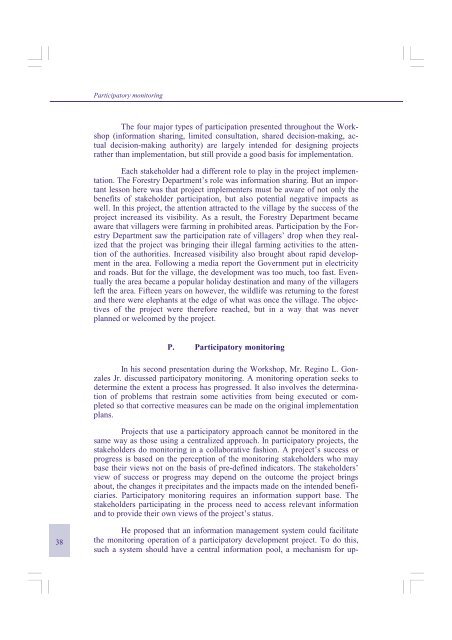Report of the Regional Workshop - Escap
Report of the Regional Workshop - Escap
Report of the Regional Workshop - Escap
You also want an ePaper? Increase the reach of your titles
YUMPU automatically turns print PDFs into web optimized ePapers that Google loves.
Participatory monitoring<br />
The four major types <strong>of</strong> participation presented throughout <strong>the</strong> <strong>Workshop</strong><br />
(information sharing, limited consultation, shared decision-making, actual<br />
decision-making authority) are largely intended for designing projects<br />
ra<strong>the</strong>r than implementation, but still provide a good basis for implementation.<br />
Each stakeholder had a different role to play in <strong>the</strong> project implementation.<br />
The Forestry Department’s role was information sharing. But an important<br />
lesson here was that project implementers must be aware <strong>of</strong> not only <strong>the</strong><br />
benefits <strong>of</strong> stakeholder participation, but also potential negative impacts as<br />
well. In this project, <strong>the</strong> attention attracted to <strong>the</strong> village by <strong>the</strong> success <strong>of</strong> <strong>the</strong><br />
project increased its visibility. As a result, <strong>the</strong> Forestry Department became<br />
aware that villagers were farming in prohibited areas. Participation by <strong>the</strong> Forestry<br />
Department saw <strong>the</strong> participation rate <strong>of</strong> villagers’ drop when <strong>the</strong>y realized<br />
that <strong>the</strong> project was bringing <strong>the</strong>ir illegal farming activities to <strong>the</strong> attention<br />
<strong>of</strong> <strong>the</strong> authorities. Increased visibility also brought about rapid development<br />
in <strong>the</strong> area. Following a media report <strong>the</strong> Government put in electricity<br />
and roads. But for <strong>the</strong> village, <strong>the</strong> development was too much, too fast. Eventually<br />
<strong>the</strong> area became a popular holiday destination and many <strong>of</strong> <strong>the</strong> villagers<br />
left <strong>the</strong> area. Fifteen years on however, <strong>the</strong> wildlife was returning to <strong>the</strong> forest<br />
and <strong>the</strong>re were elephants at <strong>the</strong> edge <strong>of</strong> what was once <strong>the</strong> village. The objectives<br />
<strong>of</strong> <strong>the</strong> project were <strong>the</strong>refore reached, but in a way that was never<br />
planned or welcomed by <strong>the</strong> project.<br />
P. Participatory monitoring<br />
In his second presentation during <strong>the</strong> <strong>Workshop</strong>, Mr. Regino L. Gonzales<br />
Jr. discussed participatory monitoring. A monitoring operation seeks to<br />
determine <strong>the</strong> extent a process has progressed. It also involves <strong>the</strong> determination<br />
<strong>of</strong> problems that restrain some activities from being executed or completed<br />
so that corrective measures can be made on <strong>the</strong> original implementation<br />
plans.<br />
Projects that use a participatory approach cannot be monitored in <strong>the</strong><br />
same way as those using a centralized approach. In participatory projects, <strong>the</strong><br />
stakeholders do monitoring in a collaborative fashion. A project’s success or<br />
progress is based on <strong>the</strong> perception <strong>of</strong> <strong>the</strong> monitoring stakeholders who may<br />
base <strong>the</strong>ir views not on <strong>the</strong> basis <strong>of</strong> pre-defined indicators. The stakeholders’<br />
view <strong>of</strong> success or progress may depend on <strong>the</strong> outcome <strong>the</strong> project brings<br />
about, <strong>the</strong> changes it precipitates and <strong>the</strong> impacts made on <strong>the</strong> intended beneficiaries.<br />
Participatory monitoring requires an information support base. The<br />
stakeholders participating in <strong>the</strong> process need to access relevant information<br />
and to provide <strong>the</strong>ir own views <strong>of</strong> <strong>the</strong> project’s status.<br />
38<br />
He proposed that an information management system could facilitate<br />
<strong>the</strong> monitoring operation <strong>of</strong> a participatory development project. To do this,<br />
such a system should have a central information pool, a mechanism for up-

















